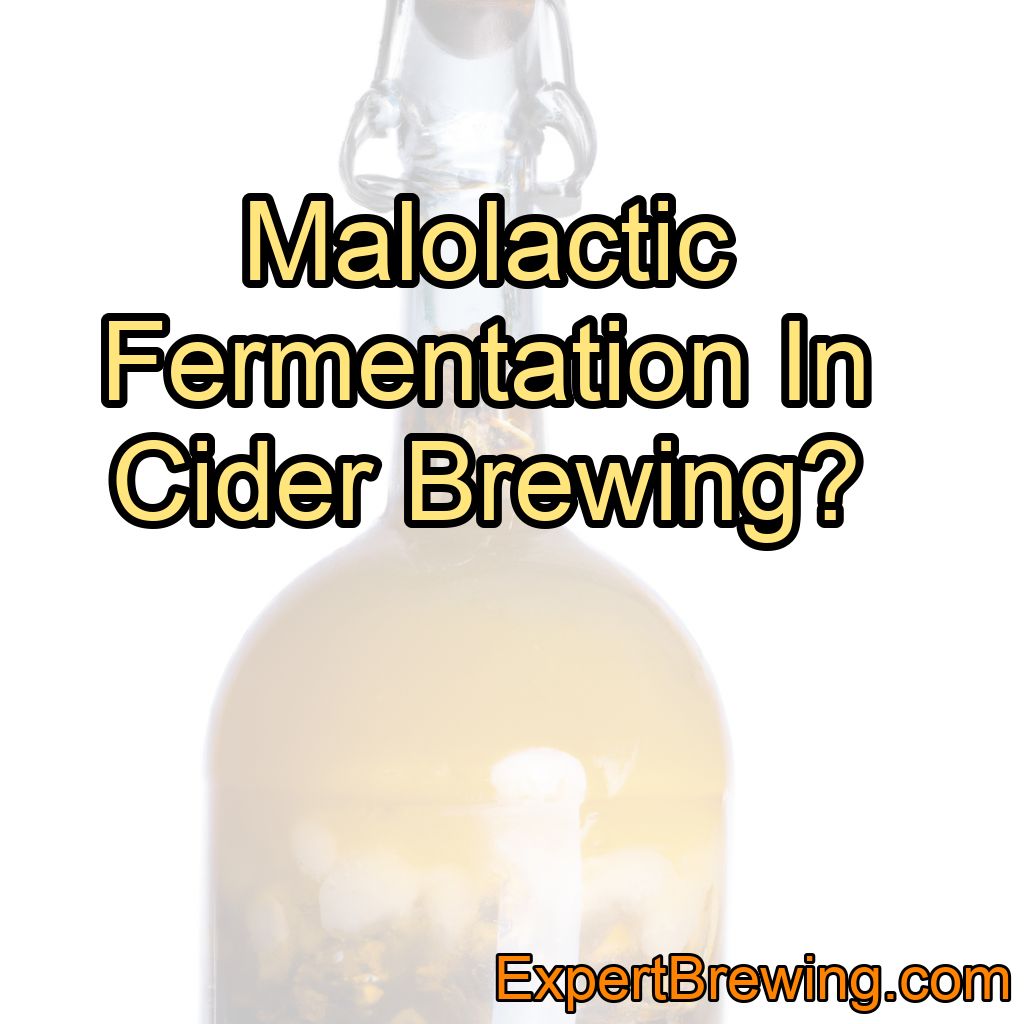Malolactic fermentation (MLF) is a process in traditional wine- and cidermaking that converts malic acid, a naturally occurring acid in grapes and apples, into lactic acid – a more mellow acid known from yoghurt!
This process not only changes the acid profile of cider, but also contributes to its flavor and stability.
In this post, we will delve deeper into the world of malolactic fermentation in cider brewing.
The Basics of Malolactic Fermentation
Malolactic fermentation, sometime also (but rarely) referred to as “secondary fermentation,” is a biological process where the malic acid in cider is converted to lactic acid by bacteria.
These bacteria, known as lactic acid bacteria (LAB), are naturally present in apples and can also be introduced to the cider during the brewing process.

The primary reason for using MLF in cider brewing is to reduce the acidity of the cider. Malic acid is a sharper, more aggressive acid, while lactic acid is softer and less noticeable on the palate. By converting the malic acid to lactic acid, MLF can make a cider taste smoother and more balanced.
The decision to use MLF in cider brewing often depends on the type of apples used and the desired end product. If the apples are particularly high in malic acid, or if a smoother, less acidic cider is desired, MLF can be a useful tool.
The Process of Malolactic Fermentation
The process of malolactic fermentation can be encouraged in a few different ways. One common method is to add a commercially available MLF starter culture to the cider. These cultures contain strains of LAB that have been specifically selected for their ability to perform MLF.
Another method is to allow the naturally occurring LAB on the apples and in the cider to carry out the fermentation. This is known as “spontaneous MLF” and can result in a more complex and unpredictable flavor profile.

Regardless of the method used, MLF usually takes place after the primary fermentation of the cider has finished. It is a slower and less vigorous process than primary fermentation and can take several weeks or even months to complete.
The Role of Temperature in Malolactic Fermentation
Temperature plays a crucial role in malolactic fermentation. LAB are sensitive to temperature and function best at around 15-20°C (59-68°F). If the temperature is too low, the bacteria may become dormant and MLF may not occur. If the temperature is too high, the bacteria may be killed or their activity may be inhibited.

Therefore, controlling the temperature during MLF is essential for a successful fermentation. This can be achieved by storing the cider in a temperature-controlled environment, such as a cellar or temperature-controlled fermentation chamber.
The Impact of Malolactic Fermentation on Cider Flavor
Malolactic fermentation can have a significant impact on the flavor of cider. The conversion of malic acid to lactic acid results in a reduction in acidity, which can make the cider taste smoother and less tart.

In addition to reducing acidity, MLF can also contribute to the flavor of cider through the production of other compounds. During the process, LAB produce a variety of byproducts, including diacetyl, which can impart a buttery or creamy flavor to the cider.
However, the impact of MLF on cider flavor can be unpredictable and depends on many factors, including the type of apples used, the strain of LAB, and the conditions of fermentation. Therefore, the decision to use MLF in cider brewing should be carefully considered and based on the desired end product.
The Risks of Malolactic Fermentation
While malolactic fermentation can contribute to the complexity and balance of cider, it is not without risks. One of the main risks is the potential for spoilage.
LAB are not the only bacteria that can perform MLF. Other bacteria, including some that can spoil cider, are also capable of this process. If these spoilage bacteria become dominant during MLF, they can produce off-flavors and spoil the cider.
Another risk is the potential for the cider to become excessively de-acidified. If too much malic acid is converted to lactic acid, the cider can become flat and lack the acidity necessary for balance and freshness.
Managing Malolactic Fermentation
Managing malolactic fermentation requires careful monitoring and control. Regular testing of the cider’s acid levels can help to track the progress of MLF and prevent excessive de-acidification.
If spoilage bacteria are a concern, sulfites can be added to the cider to inhibit their growth. However, sulfites can also inhibit LAB and slow down MLF, so they should be used judiciously.
Another strategy is to blend ciders. If a cider has undergone MLF and become too smooth or de-acidified, it can be blended with a cider that has not undergone MLF to restore balance.
The Beauty of Malolactic Fermentation
Despite its challenges, malolactic fermentation is a beautiful process that can add complexity and nuance to cider. It is a testament to the power of nature and the skill of the cider maker.
Each batch of cider that undergoes MLF is unique, shaped by the specific conditions of the fermentation and the characteristics of the apples used. The result is a cider that is a true expression of its origin and the artisanal craft of cider making.
Conclusion
Malolactic fermentation is a complex process that can greatly influence the taste, aroma, and overall character of cider. While it can be a challenge to manage, the potential rewards are immense, and the resulting cider can be a truly unique expression of the cider maker’s skill and the apples’ terroir.
Here are 10 key facts about malolactic fermentation in cider brewing:
1. Malolactic fermentation is a process where malic acid is converted to lactic acid by bacteria.
2. The primary reason for using MLF in cider brewing is to reduce the cider’s acidity.
3. MLF can be encouraged by adding a commercially available MLF starter culture or allowing a spontaneous MLF with naturally occurring bacteria.
4. Temperature plays a crucial role in MLF, with the optimal temperature range being 15-20°C (59-68°F).
5. MLF can impact the flavor of cider, reducing acidity and potentially adding buttery or creamy flavors.
6. The impact of MLF on cider flavor can be unpredictable and depends on many factors, including the type of apples used and the conditions of fermentation.
7. Risks of MLF include potential spoilage and excessive de-acidification of the cider.
8. Managing MLF requires careful monitoring and control, with regular testing of the cider’s acid levels being crucial.
9. Strategies to control MLF include the judicious use of sulfites and blending ciders.
10. Despite its challenges, MLF is a beautiful process that can add complexity and nuance to cider.
As a cider maker, I’ve seen firsthand the transformative power of malolactic fermentation. It’s not always an easy process to manage, but when done well, the results can be truly spectacular. I encourage any cider enthusiast to explore the world of MLF—it’s a fascinating journey that can take your cider to new heights.
FAQs
Does cider go through malolactic fermentation?
Yes, cider can undergo malolactic fermentation if no sulfites have been added and the juice used is not pasteurized.
Should I add malic acid to cider?
Sometimes, adding malic acid to cider can enhance its flavor profile by providing a crisp and tart taste.
Do all wines go through malolactic fermentation?
No, not all wines go through malolactic fermentation. It is a secondary fermentation process that converts malic acid into lactic acid, giving the wine a smoother and creamier taste. Some wines, particularly those that aim to retain a crisp and fruity flavor profile, intentionally avoid malolactic fermentation.
What types of wines typically do not go through malolactic conversion?
Some wines that typically do not undergo malolactic conversion are light-bodied white wines such as Riesling, Sauvignon Blanc, and Muscadet. Additionally, some red wines like Beaujolais Nouveau and certain styles of Pinot Noir are also known for not going through malolactic fermentation.
What other types of fermentation occurs in cider?
The main type of fermentation that occurs in cider is known as alcoholic fermentation and is carried out by the yeast. Other types may include the conversion of alcohol into acetic acid or conversion of amino acids into aromatic compounds etc.




